KIA Sorento 2006 1.G Owner's Manual
Manufacturer: KIA, Model Year: 2006, Model line: Sorento, Model: KIA Sorento 2006 1.GPages: 312, PDF Size: 5.21 MB
Page 211 of 312
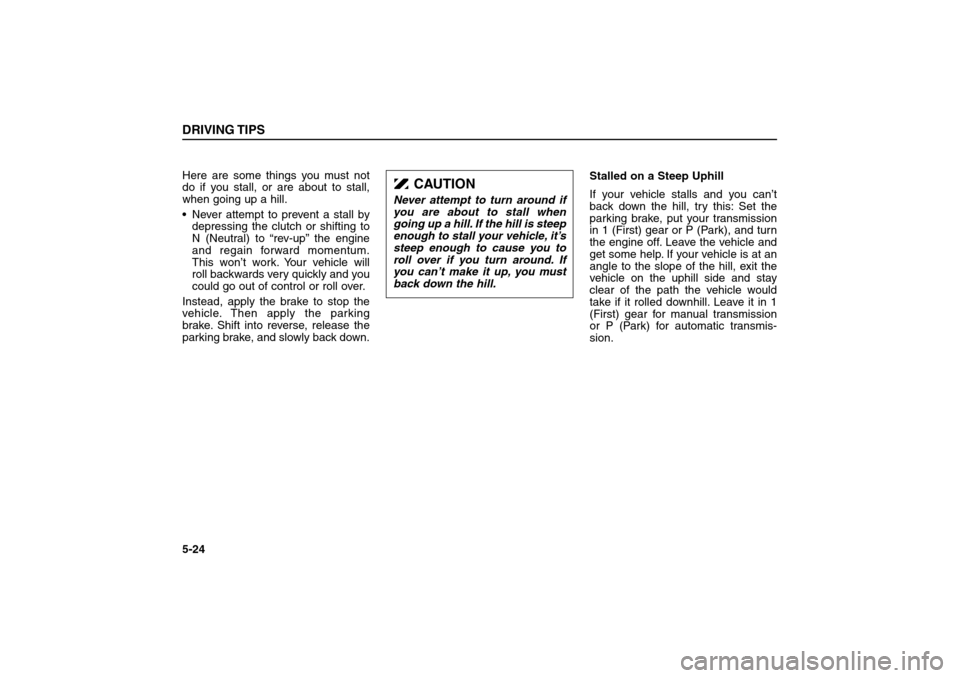
Here are some things you must not
do if you stall, or are about to stall,
when going up a hill.
Never attempt to prevent a stall by
depressing the clutch or shifting to
N (Neutral) to “rev-up” the engine
and regain forward momentum.
This won’t work. Your vehicle will
roll backwards very quickly and you
could go out of control or roll over.
Instead, apply the brake to stop the
vehicle. Then apply the parking
brake. Shift into reverse, release the
parking brake, and slowly back down.Stalled on a Steep Uphill
If your vehicle stalls and you can’t
back down the hill, try this: Set the
parking brake, put your transmission
in 1 (First) gear or P (Park), and turn
the engine off. Leave the vehicle and
get some help. If your vehicle is at an
angle to the slope of the hill, exit the
vehicle on the uphill side and stay
clear of the path the vehicle would
take if it rolled downhill. Leave it in 1
(First) gear for manual transmission
or P (Park) for automatic transmis-
sion.DRIVING TIPS5-24
CAUTION
Never attempt to turn around if
you are about to stall when
going up a hill. If the hill is steep
enough to stall your vehicle, it’s
steep enough to cause you to
roll over if you turn around. If
you can’t make it up, you must
back down the hill.
BL-ENG (CAN)-5.qxd 7/28/05 5:56 PM Page 24
Page 212 of 312
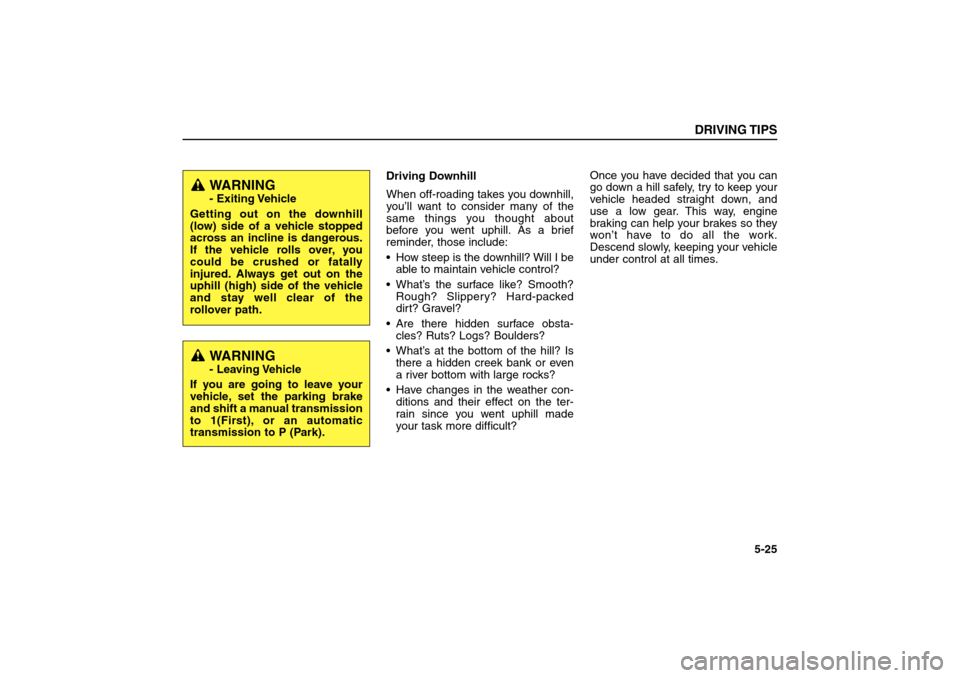
Driving Downhill
When off-roading takes you downhill,
you’ll want to consider many of the
same things you thought about
before you went uphill. As a brief
reminder, those include:
How steep is the downhill? Will I be
able to maintain vehicle control?
What’s the surface like? Smooth?
Rough? Slippery? Hard-packed
dirt? Gravel?
Are there hidden surface obsta-
cles? Ruts? Logs? Boulders?
What’s at the bottom of the hill? Is
there a hidden creek bank or even
a river bottom with large rocks?
Have changes in the weather con-
ditions and their effect on the ter-
rain since you went uphill made
your task more difficult?Once you have decided that you can
go down a hill safely, try to keep your
vehicle headed straight down, and
use a low gear. This way, engine
braking can help your brakes so they
won’t have to do all the work.
Descend slowly, keeping your vehicle
under control at all times.
DRIVING TIPS
5-25
WARNING- Exiting Vehicle
Getting out on the downhill
(low) side of a vehicle stopped
across an incline is dangerous.
If the vehicle rolls over, you
could be crushed or fatally
injured. Always get out on the
uphill (high) side of the vehicle
and stay well clear of the
rollover path.WARNING - Leaving Vehicle
If you are going to leave your
vehicle, set the parking brake
and shift a manual transmission
to 1(First), or an automatic
transmission to P (Park).
BL-ENG (CAN)-5.qxd 7/28/05 5:56 PM Page 25
Page 213 of 312
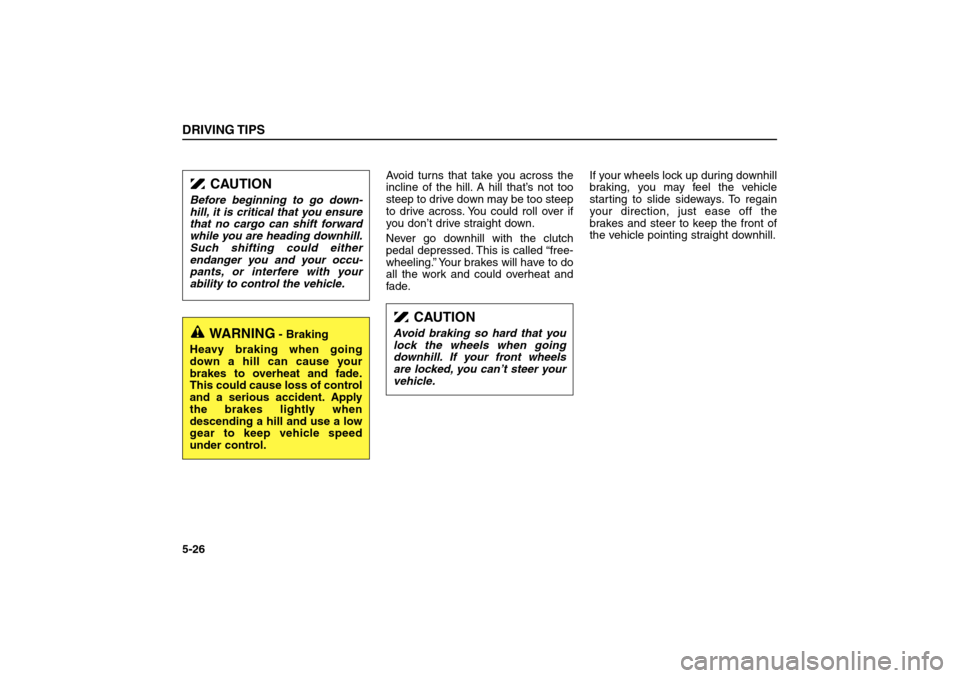
Avoid turns that take you across the
incline of the hill. A hill that’s not too
steep to drive down may be too steep
to drive across. You could roll over if
you don’t drive straight down.
Never go downhill with the clutch
pedal depressed. This is called “free-
wheeling.” Your brakes will have to do
all the work and could overheat and
fade.If your wheels lock up during downhill
braking, you may feel the vehicle
starting to slide sideways. To regain
your direction, just ease off the
brakes and steer to keep the front of
the vehicle pointing straight downhill.
DRIVING TIPS5-26
CAUTION
Before beginning to go down-
hill, it is critical that you ensure
that no cargo can shift forward
while you are heading downhill.
Such shifting could either
endanger you and your occu-
pants, or interfere with your
ability to control the vehicle.
WARNING
- Braking
Heavy braking when going
down a hill can cause your
brakes to overheat and fade.
This could cause loss of control
and a serious accident. Apply
the brakes lightly when
descending a hill and use a low
gear to keep vehicle speed
under control.
CAUTION
Avoid braking so hard that you
lock the wheels when going
downhill. If your front wheels
are locked, you can’t steer your
vehicle.
BL-ENG (CAN)-5.qxd 7/28/05 5:56 PM Page 26
Page 214 of 312
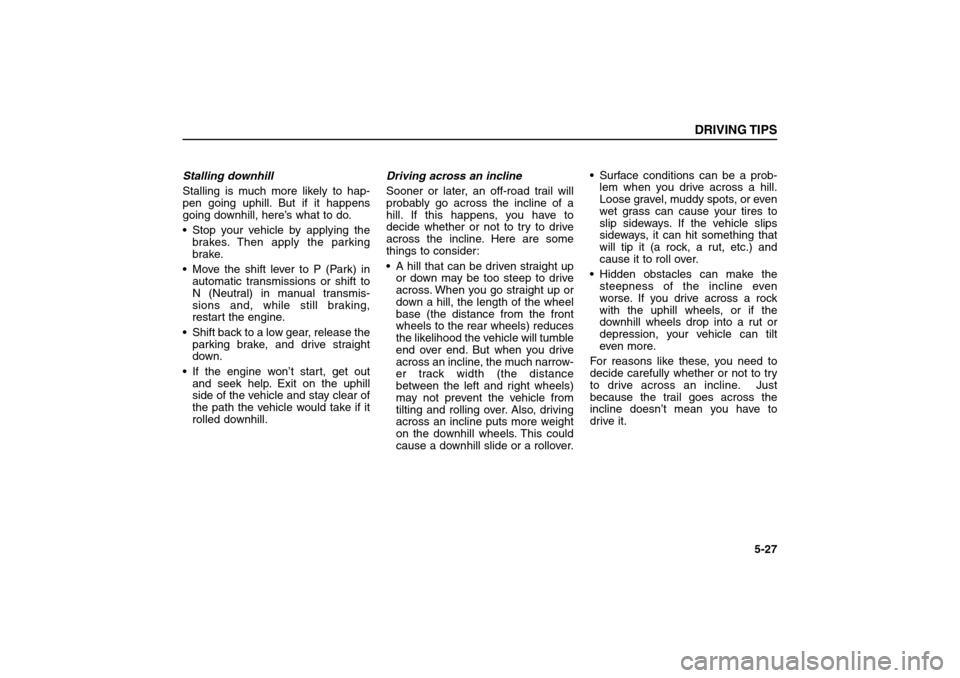
Stalling downhill
Stalling is much more likely to hap-
pen going uphill. But if it happens
going downhill, here’s what to do.
Stop your vehicle by applying the
brakes. Then apply the parking
brake.
Move the shift lever to P (Park) in
automatic transmissions or shift to
N (Neutral) in manual transmis-
sions and, while still braking,
restart the engine.
Shift back to a low gear, release the
parking brake, and drive straight
down.
If the engine won’t start, get out
and seek help. Exit on the uphill
side of the vehicle and stay clear of
the path the vehicle would take if it
rolled downhill.Driving across an incline
Sooner or later, an off-road trail will
probably go across the incline of a
hill. If this happens, you have to
decide whether or not to try to drive
across the incline. Here are some
things to consider:
A hill that can be driven straight up
or down may be too steep to drive
across. When you go straight up or
down a hill, the length of the wheel
base (the distance from the front
wheels to the rear wheels) reduces
the likelihood the vehicle will tumble
end over end. But when you drive
across an incline, the much narrow-
er track width (the distance
between the left and right wheels)
may not prevent the vehicle from
tilting and rolling over. Also, driving
across an incline puts more weight
on the downhill wheels. This could
cause a downhill slide or a rollover. Surface conditions can be a prob-
lem when you drive across a hill.
Loose gravel, muddy spots, or even
wet grass can cause your tires to
slip sideways. If the vehicle slips
sideways, it can hit something that
will tip it (a rock, a rut, etc.) and
cause it to roll over.
Hidden obstacles can make the
steepness of the incline even
worse. If you drive across a rock
with the uphill wheels, or if the
downhill wheels drop into a rut or
depression, your vehicle can tilt
even more.
For reasons like these, you need to
decide carefully whether or not to try
to drive across an incline. Just
because the trail goes across the
incline doesn’t mean you have to
drive it.
DRIVING TIPS
5-27
BL-ENG (CAN)-5.qxd 7/28/05 5:56 PM Page 27
Page 215 of 312
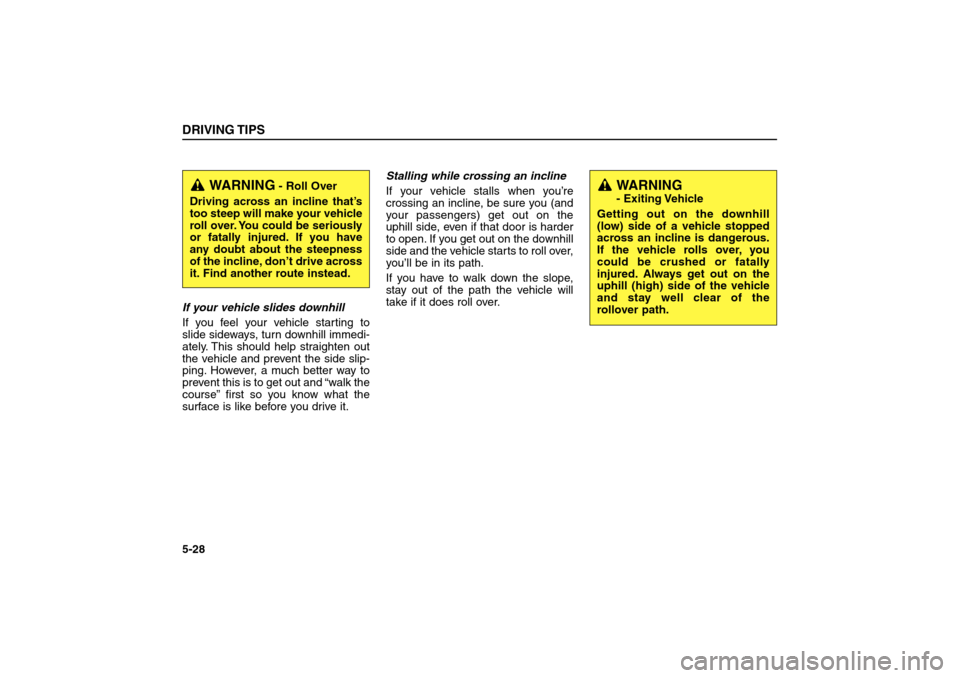
If your vehicle slides downhill
If you feel your vehicle starting to
slide sideways, turn downhill immedi-
ately. This should help straighten out
the vehicle and prevent the side slip-
ping. However, a much better way to
prevent this is to get out and “walk the
course” first so you know what the
surface is like before you drive it.Stalling while crossing an incline
If your vehicle stalls when you’re
crossing an incline, be sure you (and
your passengers) get out on the
uphill side, even if that door is harder
to open. If you get out on the downhill
side and the vehicle starts to roll over,
you’ll be in its path.
If you have to walk down the slope,
stay out of the path the vehicle will
take if it does roll over.DRIVING TIPS5-28
WARNING
- Roll Over
Driving across an incline that’s
too steep will make your vehicle
roll over. You could be seriously
or fatally injured. If you have
any doubt about the steepness
of the incline, don’t drive across
it. Find another route instead.
WARNING- Exiting Vehicle
Getting out on the downhill
(low) side of a vehicle stopped
across an incline is dangerous.
If the vehicle rolls over, you
could be crushed or fatally
injured. Always get out on the
uphill (high) side of the vehicle
and stay well clear of the
rollover path.
BL-ENG (CAN)-5.qxd 7/28/05 5:56 PM Page 28
Page 216 of 312
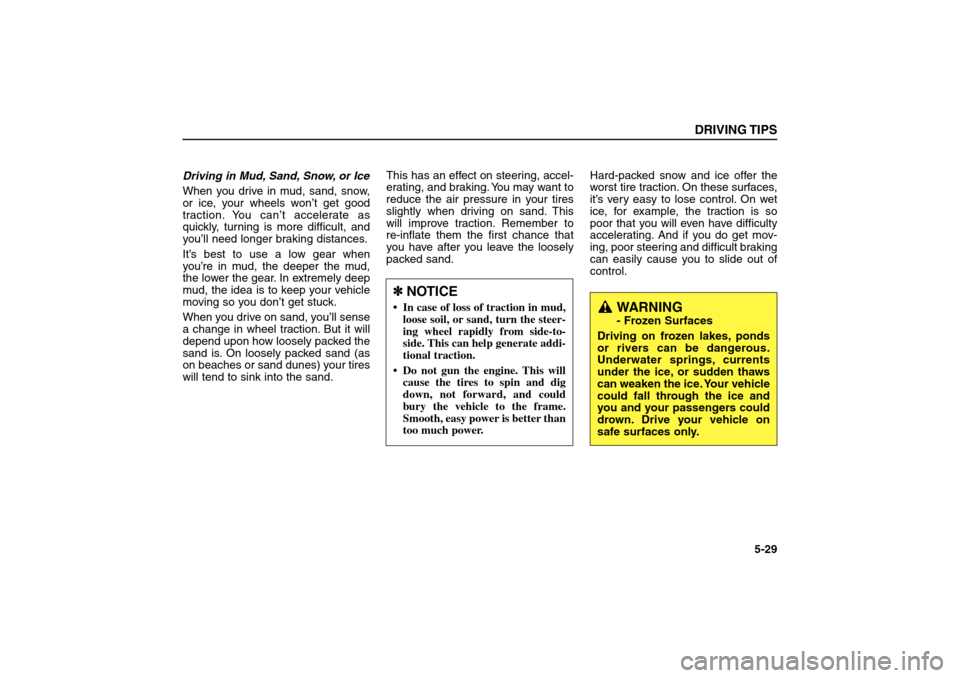
Driving in Mud, Sand, Snow, or Ice
When you drive in mud, sand, snow,
or ice, your wheels won’t get good
traction. You can’t accelerate as
quickly, turning is more difficult, and
you’ll need longer braking distances.
It’s best to use a low gear when
you’re in mud, the deeper the mud,
the lower the gear. In extremely deep
mud, the idea is to keep your vehicle
moving so you don’t get stuck.
When you drive on sand, you’ll sense
a change in wheel traction. But it will
depend upon how loosely packed the
sand is. On loosely packed sand (as
on beaches or sand dunes) your tires
will tend to sink into the sand.This has an effect on steering, accel-
erating, and braking. You may want to
reduce the air pressure in your tires
slightly when driving on sand. This
will improve traction. Remember to
re-inflate them the first chance that
you have after you leave the loosely
packed sand.Hard-packed snow and ice offer the
worst tire traction. On these surfaces,
it’s very easy to lose control. On wet
ice, for example, the traction is so
poor that you will even have difficulty
accelerating. And if you do get mov-
ing, poor steering and difficult braking
can easily cause you to slide out of
control.
DRIVING TIPS
5-29
✽ ✽
NOTICE In case of loss of traction in mud,
loose soil, or sand, turn the steer-
ing wheel rapidly from side-to-
side. This can help generate addi-
tional traction.
Do not gun the engine. This will
cause the tires to spin and dig
down, not forward, and could
bury the vehicle to the frame.
Smooth, easy power is better than
too much power.
WARNING- Frozen Surfaces
Driving on frozen lakes, ponds
or rivers can be dangerous.
Underwater springs, currents
under the ice, or sudden thaws
can weaken the ice. Your vehicle
could fall through the ice and
you and your passengers could
drown. Drive your vehicle on
safe surfaces only.
BL-ENG (CAN)-5.qxd 7/28/05 5:56 PM Page 29
Page 217 of 312
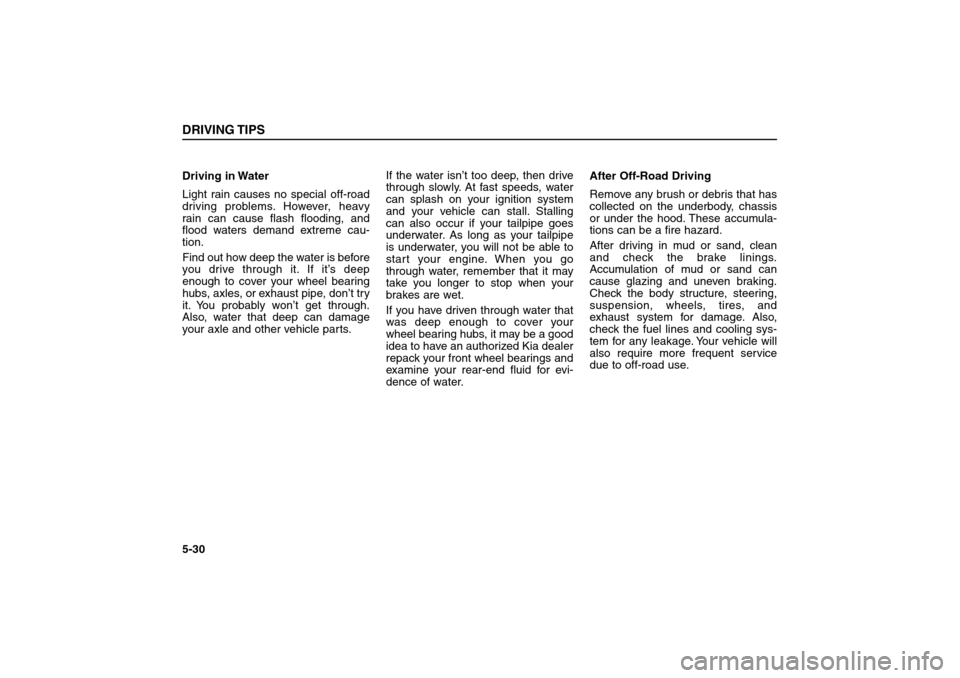
Driving in Water
Light rain causes no special off-road
driving problems. However, heavy
rain can cause flash flooding, and
flood waters demand extreme cau-
tion.
Find out how deep the water is before
you drive through it. If it’s deep
enough to cover your wheel bearing
hubs, axles, or exhaust pipe, don’t try
it. You probably won’t get through.
Also, water that deep can damage
your axle and other vehicle parts.If the water isn’t too deep, then drive
through slowly. At fast speeds, water
can splash on your ignition system
and your vehicle can stall. Stalling
can also occur if your tailpipe goes
underwater. As long as your tailpipe
is underwater, you will not be able to
start your engine. When you go
through water, remember that it may
take you longer to stop when your
brakes are wet.
If you have driven through water that
was deep enough to cover your
wheel bearing hubs, it may be a good
idea to have an authorized Kia dealer
repack your front wheel bearings and
examine your rear-end fluid for evi-
dence of water.After Off-Road Driving
Remove any brush or debris that has
collected on the underbody, chassis
or under the hood. These accumula-
tions can be a fire hazard.
After driving in mud or sand, clean
and check the brake linings.
Accumulation of mud or sand can
cause glazing and uneven braking.
Check the body structure, steering,
suspension, wheels, tires, and
exhaust system for damage. Also,
check the fuel lines and cooling sys-
tem for any leakage. Your vehicle will
also require more frequent service
due to off-road use.DRIVING TIPS5-30
BL-ENG (CAN)-5.qxd 7/28/05 5:56 PM Page 30
Page 218 of 312
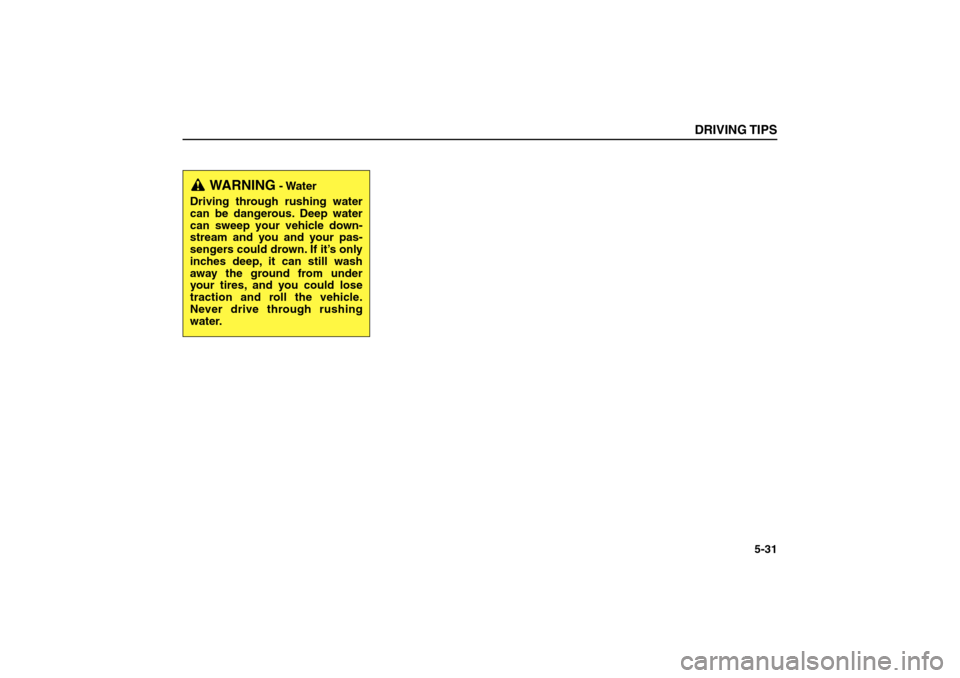
DRIVING TIPS
5-31
WARNING
- Water
Driving through rushing water
can be dangerous. Deep water
can sweep your vehicle down-
stream and you and your pas-
sengers could drown. If it’s only
inches deep, it can still wash
away the ground from under
your tires, and you could lose
traction and roll the vehicle.
Never drive through rushing
water.
BL-ENG (CAN)-5.qxd 7/28/05 5:56 PM Page 31
Page 219 of 312

WEIGHT OF THE VEHICLE -
WITH AND WITHOUT A
TRAILERThis section will guide you in the
proper loading of your vehicle and/or
trailer, to keep your loaded vehicle
weight within its design rating capa-
bility, with or without a trailer. Properly
loading your vehicle will provide max-
imum return of the vehicle design
performance. Before loading your
vehicle, familiarize yourself with the
following terms for determining your
vehicle’s weight ratings, with or with-
out a trailer, from the vehicle’s
Specifications and Tire Information
Label:Base Curb Weight
This is the weight of the vehicle
including a full tank of fuel and all
standard equipment. It does not
include passengers, cargo, or option-
al equipment.
Vehicle Curb Weight
This is the weight of your new vehicle
when you picked it up from your deal-
er plus any aftermarket equipment.
Cargo Weight
This figure includes all weight added
to the Base Curb Weight, including
cargo and optional equipment. When
towing, trailer tongue load or king pin
weight also is part of the Cargo
Weight.
GAW (Gross Axle Weight)
This is the total weight placed on
each axle (front and rear) - including
vehicle curb weight and all payload.GAWR (Gross Axle Weight Rating)
This is the maximum allowable
weight that can be carried by a single
axle (front or rear). These numbers
are shown on Tire Information Label
and Specifications. The total load on
each axle must never exceed its
GAWR.
GVW (Gross Vehicle Weight)
This is the Base Curb Weight plus
actual Cargo Weight plus passen-
gers.
GVWR (Gross Vehicle Weight
Rating)
This is the maximum allowable
weight of the fully loaded vehicle
(including all options, equipment,
passengers and cargo). The GVWR
is shown on the Vehicle Certification
Label located on the driver’s door pil-
lar and Specifications table.DRIVING TIPS5-32
BL-ENG (CAN)-5.qxd 7/28/05 5:56 PM Page 32
Page 220 of 312
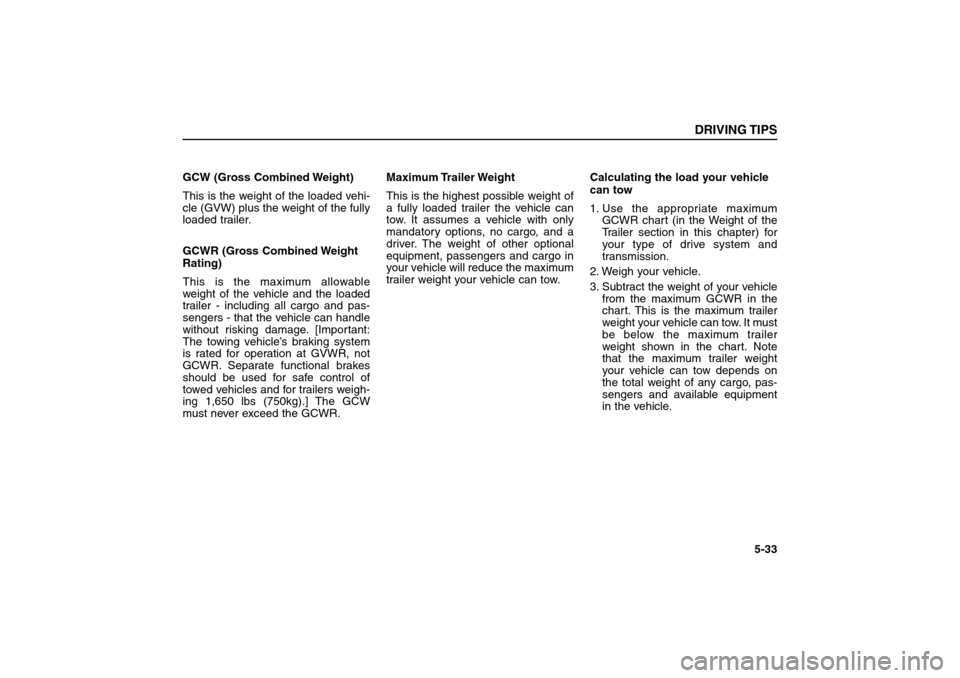
GCW (Gross Combined Weight)
This is the weight of the loaded vehi-
cle (GVW) plus the weight of the fully
loaded trailer.
GCWR (Gross Combined Weight
Rating)
This is the maximum allowable
weight of the vehicle and the loaded
trailer - including all cargo and pas-
sengers - that the vehicle can handle
without risking damage. [Important:
The towing vehicle’s braking system
is rated for operation at GVWR, not
GCWR. Separate functional brakes
should be used for safe control of
towed vehicles and for trailers weigh-
ing 1,650 lbs (750kg).] The GCW
must never exceed the GCWR.Maximum Trailer Weight
This is the highest possible weight of
a fully loaded trailer the vehicle can
tow. It assumes a vehicle with only
mandatory options, no cargo, and a
driver. The weight of other optional
equipment, passengers and cargo in
your vehicle will reduce the maximum
trailer weight your vehicle can tow.Calculating the load your vehicle
can tow
1. Use the appropriate maximum
GCWR chart (in the Weight of the
Trailer section in this chapter) for
your type of drive system and
transmission.
2. Weigh your vehicle.
3. Subtract the weight of your vehicle
from the maximum GCWR in the
chart. This is the maximum trailer
weight your vehicle can tow. It must
be below the maximum trailer
weight shown in the chart. Note
that the maximum trailer weight
your vehicle can tow depends on
the total weight of any cargo, pas-
sengers and available equipment
in the vehicle.
DRIVING TIPS
5-33
BL-ENG (CAN)-5.qxd 7/28/05 5:56 PM Page 33